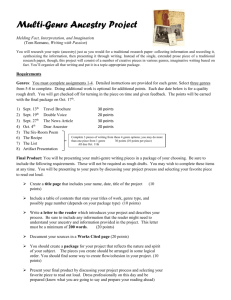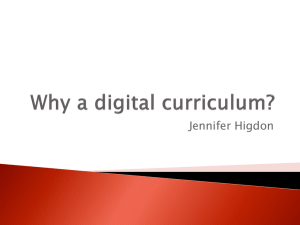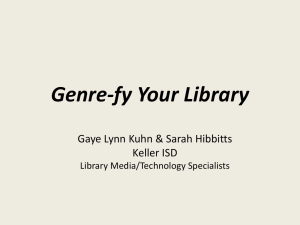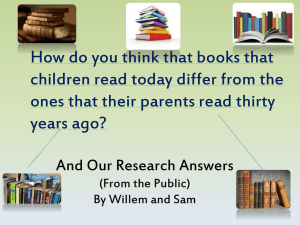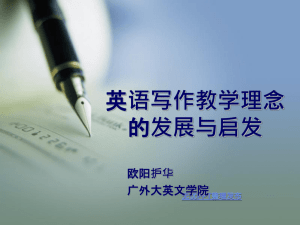Exploring Genres--Page How Sixth
advertisement
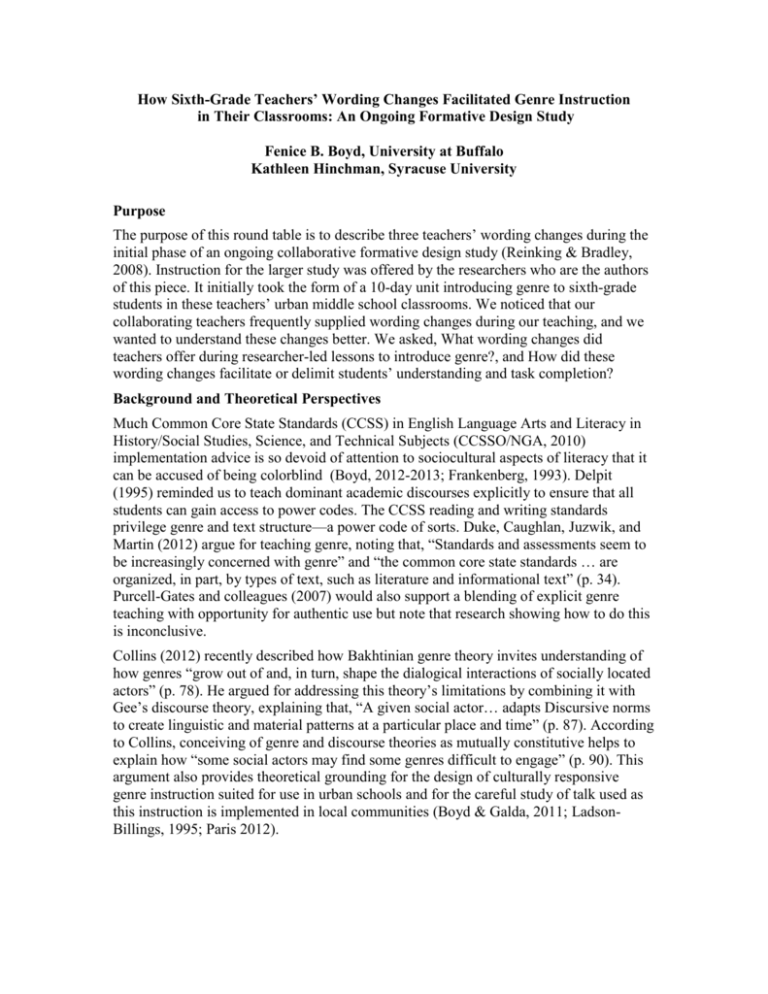
How Sixth-Grade Teachers’ Wording Changes Facilitated Genre Instruction in Their Classrooms: An Ongoing Formative Design Study Fenice B. Boyd, University at Buffalo Kathleen Hinchman, Syracuse University Purpose The purpose of this round table is to describe three teachers’ wording changes during the initial phase of an ongoing collaborative formative design study (Reinking & Bradley, 2008). Instruction for the larger study was offered by the researchers who are the authors of this piece. It initially took the form of a 10-day unit introducing genre to sixth-grade students in these teachers’ urban middle school classrooms. We noticed that our collaborating teachers frequently supplied wording changes during our teaching, and we wanted to understand these changes better. We asked, What wording changes did teachers offer during researcher-led lessons to introduce genre?, and How did these wording changes facilitate or delimit students’ understanding and task completion? Background and Theoretical Perspectives Much Common Core State Standards (CCSS) in English Language Arts and Literacy in History/Social Studies, Science, and Technical Subjects (CCSSO/NGA, 2010) implementation advice is so devoid of attention to sociocultural aspects of literacy that it can be accused of being colorblind (Boyd, 2012-2013; Frankenberg, 1993). Delpit (1995) reminded us to teach dominant academic discourses explicitly to ensure that all students can gain access to power codes. The CCSS reading and writing standards privilege genre and text structure—a power code of sorts. Duke, Caughlan, Juzwik, and Martin (2012) argue for teaching genre, noting that, “Standards and assessments seem to be increasingly concerned with genre” and “the common core state standards … are organized, in part, by types of text, such as literature and informational text” (p. 34). Purcell-Gates and colleagues (2007) would also support a blending of explicit genre teaching with opportunity for authentic use but note that research showing how to do this is inconclusive. Collins (2012) recently described how Bakhtinian genre theory invites understanding of how genres “grow out of and, in turn, shape the dialogical interactions of socially located actors” (p. 78). He argued for addressing this theory’s limitations by combining it with Gee’s discourse theory, explaining that, “A given social actor… adapts Discursive norms to create linguistic and material patterns at a particular place and time” (p. 87). According to Collins, conceiving of genre and discourse theories as mutually constitutive helps to explain how “some social actors may find some genres difficult to engage” (p. 90). This argument also provides theoretical grounding for the design of culturally responsive genre instruction suited for use in urban schools and for the careful study of talk used as this instruction is implemented in local communities (Boyd & Galda, 2011; LadsonBillings, 1995; Paris 2012). Exploring Genres--Page 2 Method Setting and participants. Our inquiry took place in three sixth-grade classrooms in two mid-sized urban school districts. One school was a charter school with two experienced teachers working in a full-day self-contained classroom and who organized ELA teaching around a reading/writing workshop framework. The other school was a more traditional middle school, with a first-year teacher who taught four sections of English language arts a day using a mix of whole class and small group instruction and a new district CCSS ELA curriculum and pacing guide. Three teachers and two researchers (one professor, one graduate student) are white, and one researcher is African-American. Instructional intervention. The first phase of our design study built on recent work on culturally sustaining pedagogy that involves youth in developing writing across genres by writing first in familar forms, in combination with studying other authors’ purposes for writing in various genres (Paris, 2012; Haddix, 2010; Kinloch, 2012). As Duke and her colleagues (2012) suggested, our introductory unit was intended to develop students’ initial understanding of authors’ purposes for using various genres and to show them how their knowledge of these purposes across genres could aid their reading comprehension and help them to develop their writing. It was meant to serve as a reference for students’ genre work throughout the school year. Plans were developed by the researchers and modified in consultation with the three sixth-grade participating teachers who were invited to co-teach the lessons with the researchers. Teacher collaborators were also invited to help refine lesson plans and give feedback on upon completion. Data sources. For the larger design study the researchers wrote field notes and lesson plans to capture planning sessions and shared these with the collaborating teachers as a member check. Data were also collected from student participants. These included all student work and a pre- and post-15-minute written survey to gather information about students’ understanding of purposes for writing in particular genres. Most important for this study was that whole-class and small-group instructional discussions were audio and video recorded to capture instructional practices, as well as student participants' and teachers' verbal reactions and comments. Audio and video recordings were transcribed. Analysis. Data were blinded, pooled, and preliminarily analyzed using constant comparison (Glaser & Strauss, 1968) to identify trends and themes of planning, teaching, and students’ responses to instruction, as well as to inform subsequent instructional design. A first analysis found that most students gained a beginning understanding of genre and were most engaged when activities connected to their experiences or involved classroom interaction (e.g., shared writing of found poetry). We realized that our intervention was enhanced when texts and teachers helped us make our points and complete tasks and inhibited by text talk and teachers’ re-explanation that took us away from lesson objectives. Mindful of Allington and Johnston’s (2002) observations about the importance of effective teachers instructional talk, we initiated a second analysis, this time yielding categories of the ways the teachers reworded our instructional talk. Findings Our collaborating teachers offered wording changes during researchers’ teaching in two sites in several ways that were intended to keep students on task and focused on our learning objectives. Their interruptions checked students’ task understandings, clarified Exploring Genres--Page 3 task directions, and helped students consider what they knew so they could answer researchers’ questions. For instance, teachers intervened by inviting students to check their understandings of task directions: “I would like you all to turn to the person next to you and share the homework assignment that is due tomorrow.” They often referred to classroom routines known to students but sometimes changed the nature of the task in the rewording, as when a researcher asked a student from each discussion table to bring a sticky note up to a classroom comparison chart, which the teacher reworded to, “Pass your stickies to your table captain, and table captain will bring them up.” The teacher’s re-wording conveys the importance of being consistent with her classroom routines and culture; one of which the research was not familiar. Teachers also helped students to answer researchers’ questions. One teacher helped a student answer such a question by drawing students’ attention to an answer source discussed earlier. The researcher had asked, “What type of genre is Superman [and Me]? One student replied, “Historical fiction?” The researcher queried, “Is it fiction?” The teacher interrupted, asking, “Is it fiction? Is he a real man?,” went to a definition slide, directed students to a list of genres, and asked “So what genre?” One student replied with a question: “A poem?,” and another said, more resolutely, “An essay.” Another type of rewording involved teachers in changing researchers’ queries to narrow the universe of possible answers. The researcher had asked, “What kinds of writing have you seen people do since we talked last week? And what was the purpose? In your family? Grocery lists?” The teacher waited for a minute of silence and added, “What about in school? What have you been seeing people write in school?” Students then began to respond: “Oh… Ms. X was writing a referral, “Ms. Y filled out an application for my dad,” “Ms. Y was writing passes,” and “I saw my mom write down a phone number so she could remember it.” Discussion and Significance With the task delineation and content narrowing offered by our teacher collaborators, we were able to engage students in tasks to explore genres in ways that resonated with urban sixth graders. Although teachers sometimes changed the tasks in their rewordings, their changes were minimal and did not seem to change student outcomes in important ways. Even this cursory analysis reminds us of how little we know about what Nystrand (2006) called sociogenesis, that is, the ways classroom talk frames students’ developing insights about reading and writing. It was a reminder of how grade and community-specific classroom discourse needs to be in order to communicate with students, a reminder that causes us to pause about the purpose of scripted instructional plans. These are areas of classroom talk that Allington (2002) has pointed out are under-researched. They will be the focus of the next iteration of this multi-phase design study of genre teaching to benefit reading and writing. Exploring Genres--Page 4 References Allington, R. L. (2002). The six t’s of effective elementary literacy instruction. (Originally published in the June 2002 issue of Phi Delta Kappan as "What I've Learned About Effective Reading Instruction From a Decade of Studying Exemplary Elementary Classroom Teachers.) Downloaded February 1, 2014 from http://www.readingrockets.org/article/96 Allington, R. L., & Johnston, P. (2002). Reading to learn: Lessons from exemplary 4th grade classrooms. New York: Guilford. Boyd, F. (2012-2013). The Common Core State Standards and diversity: Unpacking the text exemplars presented in Appendix B. Reading Today, 30(3), 10-11. Boyd, M., & Galda, L. (2011). Real talk in elementary classrooms: Effective oral language practice. New York, NY: Guilford. CCSSO/NGA (2010). Common Core State Standards for English Language Arts & Literacy in History/Social Studies, Science, and Technical Subjects. Washington, DC: Council of Chief State School Officers & National Governors Association. Collin, R. (2012). Genre in discourse, discourse in genre: A new approach to the study of literate practice. Journal of Literacy Research, 44(1), 76-96. Delpit, L. (1995). Other people’s children: Cultural conflict in the classroom. New York, NY: New Press. Duke, N.K., Caughlin, S., Juzwik, M.M., & Martin, N.M. (2012). Reading and writing genre with purpose in K-8 classrooms. Portsmouth, NY: Heinemann. Frankenberg, R. (1993). White women race matters: The social construction of whiteness. Minneapolis, MN: University of Minnesota Press. Glaser, B., & Strauss, A. (1968). The discovery of grounded theory. New York, NY: Aldine. Haddix, M. (2010). Black boys can write: Challenging dominant framings of African American Adolescent males in literacy research. Journal of Adolescent and Adult Literacy, 53, 341-343. Kinloch, V. (2012). Crossing boundaries: Teaching and learning with urban youth. New York: NY: Teachers College press. Nystrand, M. (2006). Research on the role of classroom discourse as it affects reading comprehension. Research in the Teaching of English, 40, 392-412. Paris, D. (2012). Culturally sustaining pedagogy: A needed change in stance, terminology, and practice. Educational Researcher, 41, 93-97. Purcell-Gates, V., Duke, N. K., & Martineau, J. A. (2007). Learning to read and write genre-specific text: Roles of authentic experience and explicit teaching. Reading Research Quarterly, 42(1), 8–45. Reinking, D., & Bradley. B. (2008). Formative and design experiments: Approaches to language and literacy research. New York: NY: Teachers College Press.
